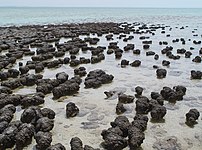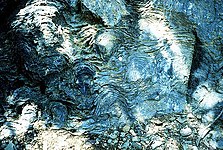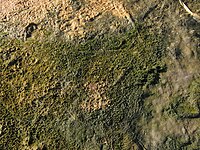Earliest known life forms - Simple English Wikipedia, the free encyclopedia
The earliest known life forms found on Earth are fossils of microorganisms in 3.46 billion year old rocks in Western Australia.[1] Life forms, as microorganisms, may have lived much earlier.
The earliest time that life forms first appeared on Earth is unknown. Life forms may have existed as early as 4.28 billion years ago. not long after the oceans were formed 4.41 billion years ago, That is not long after the formation of the Earth 4.54 billion years ago.[2]
A life form, or lifeform, is an organism that is living. Estimates of the number of species of life forms on Earth range from 14 million, to as many as 1 trillion species.[3] More than 99% of all species of life forms that have ever lived on Earth are thought to be extinct.[4] Life forms may be found everywhere on Earth. This includes underground,[5] possibly at least 12 miles deep underground,[6] and the deepest parts of the oceans. Life can be found at least 47 miles high in the atmosphere[7] and, under test conditions, it survives the vacuum of outer space.[8]
According to one researcher, "You can find microbes everywhere – [they are] extremely adaptable to conditions, and survive wherever they are".[9]
Earliest life forms[change | change source]
Fossil evidence is at the basis of most studies about the origin of life. The age of the Earth is about 4.54 billion years; the best evidence of early life on Earth dates from at least 3.46 billion years ago.[1]
In 2017, fossils of fossilized microorganisms were reported to have been discovered near hydrothermal vents in Quebec, Canada. These fossils are thought to be at least 3.779 million years old.[10]
Also in 2017, evidence of life on land may have been found in 3.48 billion-year-old rocks, discovered in Western Australia, that are usually found around hot springs and geysers.[11]
In November 2017, a study by the University of Edinburgh suggested that life on Earth may have originated from biological particles carried by streams of space dust.[12]
Nonetheless, according to biologist Stephen Blair Hedges, "If life arose relatively quickly on Earth … then it could be common in the universe."[13]
Gallery[change | change source]
- Stromatolites may have been made by microbes.
- Stromatolites left behind by microbes are one of the oldest fossils of life.
- The microbe-algal mat, salty lake on the White Sea seaside.
- Sedimentary structures formed by microbes near an ocean beach.
- Structures formed by microbes near the Niagara Gorge, NY.
Related pages[change | change source]
References[change | change source]
- ↑ 1.0 1.1 Tyrell, Kelly April (18 December 2017). "Oldest fossils ever found show life on Earth began before 3.5 billion years ago". University of Wisconsin-Madison. Retrieved 16 December 2018.
- ↑ Betts, Holly C.; et al. (20 August 2018). "Integrated genomic and fossil evidence illuminates life's early evolution and eukaryote origin". Nature Ecology & Evolution. 2 (10): 1556–1562. doi:10.1038/s41559-018-0644-x. PMC 6152910. PMID 30127539.
- ↑ Staff (2 May 2016). "Researchers find that Earth may be home to 1 trillion species". National Science Foundation. Retrieved 16 December 2018.
- ↑ Kunin, W.E.; Gaston, Kevin, eds. (31 December 1996). The biology of rarity: causes and consequences of rare—common differences. Springer. ISBN 978-0412633805. Retrieved 16 December 2018.
- ↑ Klein, JoAnna (19 December 2018). "Deep Beneath Your Feet, They Live in the Octillions - The real journey to the center of the Earth has begun, and scientists are discovering subsurface microbial beings that shake up what we think we know about life". The New York Times. Retrieved 21 December 2018.
- ↑ Hadhazy, Adam (12 January 2015). "Life might thrive a dozen miles beneath Earth's surface". Astrobiology Magazine. Archived from the original on 16 August 2018. Retrieved 17 December 2018.
- ↑ Loeb, Abraham (4 November 2019). "Did Life from Earth Escape the Solar System Eons Ago? - There's no proof that it happened—but it's not impossible". Scientific American. Retrieved 5 November 2019.
- ↑ Dvorsky, George (13 September 2017). "Alarming Study Indicates Why Certain Bacteria Are More Resistant to Drugs in Space". Gizmodo. Retrieved 16 December 2018.
- ↑ Choi, Charles Q. (17 March 2013). "Microbes thrive in deepest spot on Earth". Live Science. Retrieved 16 December 2018.
- ↑ Dodd, Matthew S. et al 2017. "Evidence for early life in Earth's oldest hydrothermal vent precipitates". Nature. 543. [1]
- ↑ Staff (9 May 2017). "Oldest evidence of life on land found in 3.48-billion-year-old Australian rocks". Phys.org. Retrieved 16 December 2018.
- ↑ Berera, Arjun (6 November 2017). "Space dust collisions as a planetary escape mechanism". Astrobiology. 17 (12): 1274–1282. arXiv:1711.01895. Bibcode:2017AsBio..17.1274B. doi:10.1089/ast.2017.1662. PMID 29148823. S2CID 126012488.
- ↑ Borenstein, Seth (19 October 2015). "Hints of life on what was thought to be desolate early Earth". AP News. Associated Press. Retrieved 16 December 2018.


 French
French Deutsch
Deutsch





